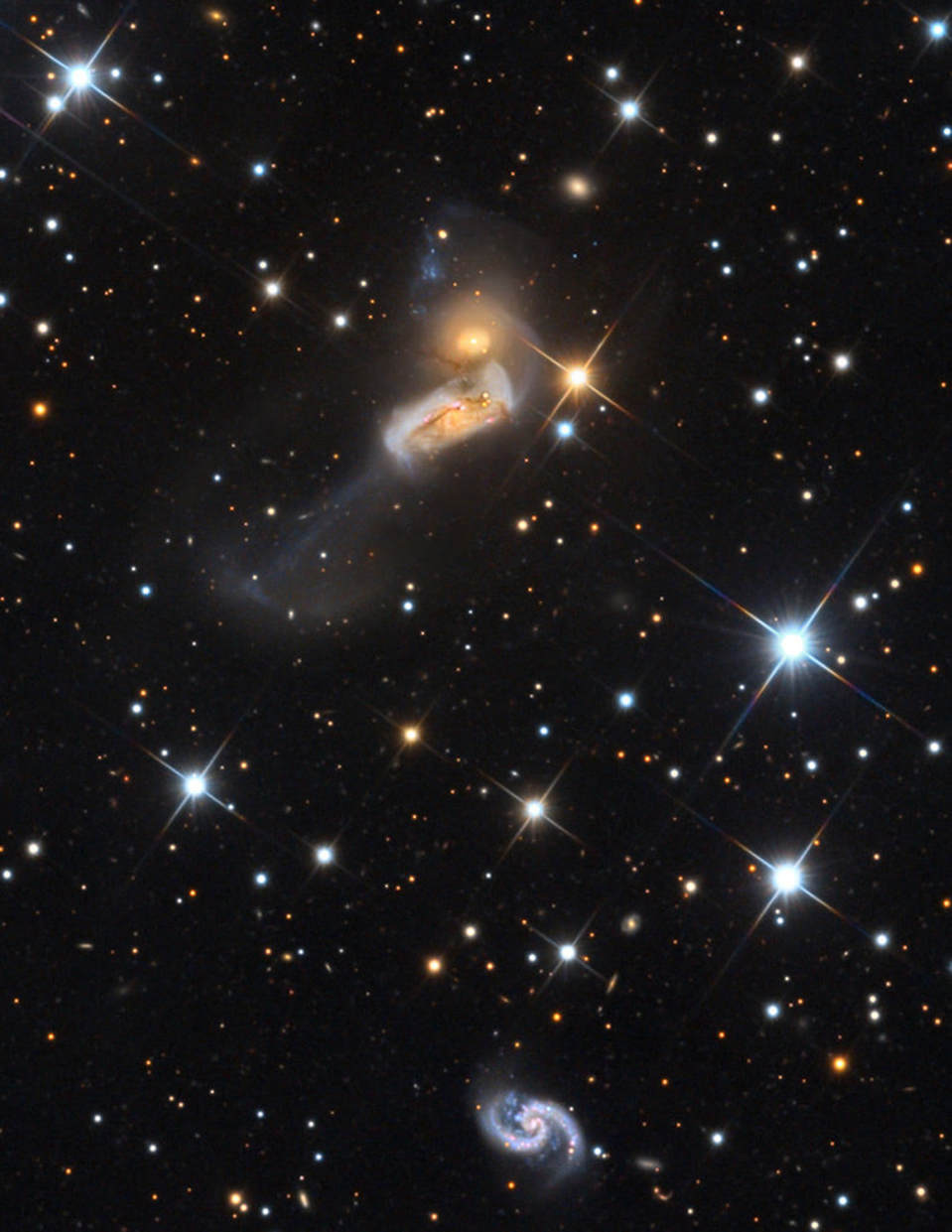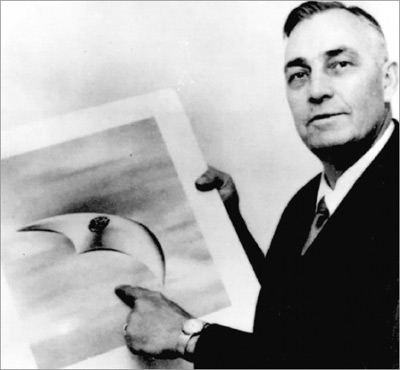Blog
The galaxy known as NGC 5907 stretches wide across this image. Appearing as an elongated line of stars and dark dust, the galaxy is categorized as a spiral galaxy just like our own Milky Way. In this new image from the NASA/ESA Hubble Space Telescope, we don’t see the beautiful spiral arms because we are viewing it edge-on, like looking at the rim of a plate. It is for this reason that NGC 5907 is also known as the Knife Edge Galaxy.
The Knife Edge Galaxy is about 50 million light-years from Earth, lying in the northern constellation of Draco. Although not visible in this image, ghostly streams of stars on large arching loops extend into space, circling around the galaxy; they are believed to be remnants of a small dwarf galaxy, torn apart by the Knife Edge Galaxy and merged with it over four billion years ago.

Gilberto Passos Gil Moreira (born 26 June 1942), known professionally as Gilberto Gil (Brazilian Portuguese: [ʒiwˈbɛʁtu ˈʒiw]), is a Brazilian singer, guitarist, and songwriter, known for both his musical innovation and political activism. From 2003 to 2008, he served as Brazil’s Minister of Culture in the administration of President Luiz Inácio Lula da Silva. Gil’s musical style incorporates an eclectic range of influences, including rock, Brazilian genres including samba, African music, and reggae.
Gil started to play music as a child and was a teenager when he joined his first band. He began his career as a bossa nova musician and grew to write songs that reflected a focus on political awareness and social activism. He was a key figure in the Música popular brasileira and tropicália movements of the 1960s, alongside artists such as longtime collaborator Caetano Veloso. The Brazilian military regime that took power in 1964 saw both Gil and Veloso as a threat, and the two were held for nine months in 1969 before they were told to leave the country. Gil moved to London, but returned to Bahia in 1972 and continued his musical career, as well as working as a politician and environmental advocate.
more...Reginald “Reggie” Workman (born June 26, 1937 in Philadelphia, Pennsylvania) is an American avant-garde jazz and hard bop double bassist, recognized for his work with both John Coltrane and Art Blakey.
Early in his career, Workman worked in jazz groups led by Gigi Gryce, Donald Byrd, Duke Jordan and Booker Little. In 1961, Workman joined the John Coltrane Quartet, replacing Steve Davis. He was present for the saxophonist’s Live at the Village Vanguard sessions, and also recorded with a second bassist (Art Davis) on the 1961 album, Olé Coltrane. Workman left Coltrane’s group at the end of the year, following a European tour.
In 1962, Workman joined Art Blakey‘s Jazz Messengers (replacing long-time Blakey bassist Jymie Merritt), and worked alongside Freddie Hubbard, Wayne Shorter, and Cedar Walton for most of this period. Workman left Blakey’s group in 1964.
Workman also played with James Moody, Yusef Lateef, Pharoah Sanders, Herbie Mann and Thelonious Monk. He has recorded with Archie Shepp, Lee Morgan and David Murray.[1] Workman, with pianist Tommy Flanagan and drummer Joe Chambers, formed The Super Jazz Trio in 1978.
He is currently a professor at The New School for Jazz and Contemporary Music in New York City, and is a member of the group, Trio 3, with Oliver Lake and Andrew Cyrille.
Workman has been a resident of Montclair, New Jersey
more...Big Bill Broonzy (born Lee Conley Bradley, June 26, 1903 – August 14, 1958) was an American blues singer, songwriter and guitarist. His career began in the 1920s, when he played country blues to mostly African-American audiences. Through the 1930s and 1940s he successfully navigated a transition in style to a more urban blues sound popular with working-class African-American audiences. In the 1950s a return to his traditional folk-blues roots made him one of the leading figures of the emerging American folk music revival and an international star. His long and varied career marks him as one of the key figures in the development of blues music in the 20th century.
Broonzy copyrighted more than 300 songs during his lifetime, including both adaptations of traditional folk songs and original blues songs. As a blues composer, he was unique in writing songs that reflected his rural-to-urban experiences.
Born Lee Conley Bradley, he was one of the seventeen children of Frank Broonzy (Bradley) and Mittie Belcher. The date and place of his birth are disputed. Broonzy claimed to have been born in Scott, Mississippi, but a body of emerging research compiled by the blues historian Robert Reisman suggests that he was born in Jefferson County, Arkansas. Broonzy claimed he was born in 1893, and many sources report that year, but family records discovered after his death suggested that the year was 1903.
more...Alegrías (Spanish pronunciation: [aleˈɣɾi.as]) is a flamenco palo or musical form, which has a rhythm consisting of 12 beats. It is similar to Soleares. Its beat emphasis is as follows: 1 2 [3] 4 5 [6] 7 [8]9 [10] 11 [12]. Alegrías originated in Cádiz. Alegrías belongs to the group of palos called Cantiñas and it is usually played in a lively rhythm (120-170 beats per minute). The livelier speeds are chosen for dancing, while quieter rhythms are preferred for the song alone.
One of the structurally strictest forms of flamenco, a traditional dance in alegrías must contain each of the following sections: a salida (entrance), paseo (walkaround), silencio (similar to an adagio in ballet), castellana (upbeat section) zapateado (Literally “a tap of the foot”) and bulerías. This structure though, is not followed when alegrías are sung as a standalone song (with no dancing). In that case, the stanzas are combined freely, sometimes together with other types of cantiñas.
Recommended listenings for this palo include most singers from Cádiz, like Chano Lobato, La Perla de Cádiz, Aurelio Sellé, but also general singers like Manolo Caracol or La Niña de los Peines.
Also, you can listen “Mar Amargo” from Camarón and “La Tarde es Caramelo” from Vicente Amigo.
It is one of the cante chico forms of flamenco. The word Alegrías literally means “joys.”
more...https://www.youtube.com/watch?v=uN7vm-k-AaA
more...NGC 317 is a pair of interacting galaxies, consisting of a lenticular galaxy (PGC 3442) and a spiral galaxy (PGC 3345), in the constellation Andromeda. It was discovered on October 1, 1885 by Lewis Swift.

Carly Elisabeth Simon (born June 25, 1945) is an American singer-songwriter, musician, and children’s author. She first rose to fame in the 1970s with a string of hit records; her 13 Top 40 U.S. hits include “Anticipation” (No. 13), “You Belong To Me” (No. 6), “Coming Around Again” (No. 18), and her four Gold certified singles “Jesse” (No. 11), “Mockingbird” (No. 5, a duet with James Taylor), “You’re So Vain” (No. 1), and “Nobody Does It Better” (No. 2) from the 1977 James Bond film The Spy Who Loved Me.
After a brief stint with her sister Lucy Simon as duo group the Simon Sisters, she found great success as a solo artist with her 1971 self-titled debut album Carly Simon, which won her the Grammy Award for Best New Artist, and spawned her first Top 10 single, “That’s the Way I’ve Always Heard It Should Be” (No. 10). Her second album, Anticipation, followed later that year and became an even greater success, earning Simon another Grammy nomination and later being certified Gold by the RIAA. She achieved international fame the following year with the release of her third album, No Secrets, which sat firmly at No. 1 on the Billboard 200 for five weeks, was certified Platinum, and spawned the worldwide hit “You’re So Vain”, for which she received three Grammy nominations, including Record of the Year and Song of the Year. With her 1988 hit “Let the River Run“, from the film Working Girl, she became the first artist to win a Grammy Award, an Academy Award, and a Golden Globe Award for a song composed and written, as well as performed, entirely by a single artist.
Over the course of her career, Simon has amassed 24 Billboard Hot 100 charting singles, 28 Billboard Adult Contemporary charting singles, and won 2 Grammy Awards, from 14 nominations. AllMusic called her “one of the quintessential singer-songwriters of the ’70s”. She has a contralto vocal range, and has cited Odetta as a significant influence. She was inducted into the Songwriters Hall of Fame in 1994. In 1995 and 1998, respectively, she received the Boston Music Awards Lifetime Achievement and a Berklee College of Music Honorary Doctor of Music Degree. She was inducted into the Grammy Hall of Fame for “You’re So Vain” in 2004 and awarded the ASCAP Founders Award in 2012.
Simon was born June 25, 1945, in the Bronx borough of New York City. Her father, Richard L. Simon, was the co-founder of Simon & Schuster and a classical pianist who often played Frédéric Chopin and Ludwig van Beethoven at home. Her mother was Andrea Heinemann Simon (née Heinemann), a civil rights activist and singer. Her father was from a German-Jewish family, while her maternal grandfather Friedrich was of German descent; her maternal grandmother, Ofelia Oliete, known as “Chibie”, was a Catholic originally from Cuba, and was of Pardo heritage, a freed-slave descendant. Ofelia was raised primarily in England by nuns until the age of sixteen. A 2017 episode of PBS show Finding Your Roots tested Simon’s DNA, which included 10% African and 2% Native American, likely via her maternal grandmother.
more...Joe Chambers (born June 25, 1942) in Chester, Pennsylvania is an American jazz drummer, pianist, vibraphonist and composer. He attended the Philadelphia Conservatory for one year. In the 1960s and 1970s Chambers gigged with many high-profile artists such as Eric Dolphy, Charles Mingus, Wayne Shorter, and Chick Corea. During this period, his compositions appeared on some of the albums in which he made guest appearances, such as those with Freddie Hubbard and Bobby Hutcherson. He has released eight albums as a bandleader and been a member of several incarnations of Max Roach‘s M’Boom percussion ensemble.
He has also taught, including at the New School for Jazz and Contemporary Music in New York City, where he leads the Outlaw Band. In 2008, he was hired to be the Thomas S. Kenan Distinguished Professor of Jazz in the Department of Music at the University of North Carolina Wilmington.
more...Clifton Chenier (June 25, 1925 – December 12, 1987), a Louisiana French-speaking native of Leonville [3], Louisiana, near Opelousas, was an eminent performer and recording artist of zydeco, which arose from Cajun and Creole music, with R&B, jazz, and blues influences. He played the accordion and won a Grammy Award in 1983. He was a recipient of a 1984 National Heritage Fellowship awarded by the National Endowment for the Arts, which is the United States government’s highest honor in the folk and traditional arts. He was inducted posthumously into the Blues Hall of Fame in 1989, and the Louisiana Music Hall of Fame in 2011. In 2014, he was a recipient of the Grammy Lifetime Achievement Award.
He was known as the King of Zydeco and also billed as the King of the South.
Chenier began his recording career in 1954, when he signed with Elko Records and released Cliston’s Blues [sic], a regional success. In 1955 he signed with Specialty Records and garnered his first national hit with his label debut “Ay-Tete Fi” (Hey, Little Girl) (a cover of Professor Longhair‘s song). The national success of the release led to numerous tours with popular rhythm and blues performers such as Ray Charles, Etta James, and Lowell Fulson. He also toured in the early days with Clarence Garlow, billed as the Two Crazy Frenchmen. Chenier was signed with Chess Records in Chicago, followed by the Arhoolie label.
more...Johnny Henry Smith II (June 25, 1922 – June 11, 2013) was an American cool jazz and mainstream jazz guitarist. He wrote “Walk, Don’t Run” in 1954. In 1984, Smith was inducted into the Alabama Jazz Hall of Fame.
During the Great Depression, Smith’s family moved from Birmingham, Alabama, United States, where Smith was born, through several cities, ending up in Portland, Maine.
Smith taught himself to play guitar in pawnshops, which let him play in exchange for keeping the guitars in tune. At thirteen years of age he was teaching others to play the guitar. One of Smith’s students bought a new guitar and gave him his old guitar, which became the first guitar Smith owned.
Smith joined Uncle Lem and the Mountain Boys, a local hillbilly band that travelled around Maine, performing at dances, fairs, and similar venues. Smith earned four dollars a night. He dropped out of high school to accommodate this enterprise.
Having become increasingly interested in the jazz bands that he heard on the radio, Smith gradually moved away from country music towards playing more jazz. He left The Mountain Boys when he was eighteen years old to join a variety trio called the Airport Boys.
more...June 24, 1947: They Came From … Outer Space?
1947: Pilot Kenneth Arnold sights a series of unidentified flying objects near Washington’s Mount Rainier. It’s the first widely reported UFO sighting in the United States, and, thanks to Arnold’s description of what he saw, leads the press to coin the term flying saucer.
Arnold was an experienced pilot with more than 9,000 hours of flying time. He had diverted from his flight plan – Chehalis to Yakima, Washington – to search for a Marine Corps C-46 transport plane reported down in the Cascades near the southwest slope of Mount Rainier. A sweep of the area revealed nothing, and Arnold resumed his original course.
As Arnold recalled, the afternoon was crystal clear, and he was cruising at an altitude of 9,200 feet. A minute or two after noting a DC-4 about 15 miles behind and to the left of him, he was startled by something bright reflecting off his plane. At first he thought he had nearly hit another aircraft but as he looked off in the direction the light had come from, he saw nine “peculiar-looking” aircraft flying rapidly in formation toward Mount Rainier.
more...Friday, May 1, 2020: A new image from the Hubble Space Telescope features the sparkling spiral galaxy NGC 4100, which is teeming with baby stars. The galaxy’s spiral arms are speckled with pockets of bright blue starlight radiating from hot newborn stars. NGC 4100 is located about 67 million light-years from Earth in the constellation Ursa Major, and it belongs to a group of galaxies called the Ursa Major Cluster. It’s about three-quarters the size of the Milky Way, which is also a spiral galaxy, and it “looks almost stretched across the sky” in this new view, Hubble scientists said in a statement. The space telescope captured this image using its Advanced Camera for Surveys, and it was released today (May 1).

More Posts
- Sing Miller Day
- World Music with Corvus Corax
- Daily Roots with ITSJAHMIEL
- The Cosmos with NGC 3372
- Lucky Thompson Day
- World Music with Sherrifo Konteh
- Daily Roots with Culture
- The Cosmos with NGC 3190
- Jaki Byard Day
- Erroll Garner Day
- World Music with Paco Soto
- Daily Roots with Amy Winehouse
- The Cosmos with RCW 57
- Marcus Miller Day
- Kenny Drew Jr Day
- Junior Walker Day
- World Music with Amadu Bansang Jobarteh
- Daily Roots with Sly & Robbie
- The Cosmos with NGC 6164
